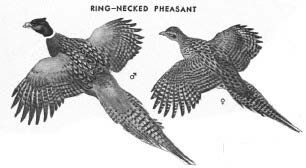
Discover rewarding casino experiences. 
|
Is it the “human bean” that is eliminating the beautiful bird, the pheasant? It used to be that at anytime driving in the country of Northwest Illinois you would see a pheasant or pheasants along the roadsides in our timber-accented landscapes. Now it’s very rare that you’ll spot one. It’s an exciting occasion for the birdwatcher. Of course it’s the lack of habitat today that is decimating the one-time numerous pheasant. Fence rows are largely gone with crops planted as far as possible to the highway. The stands of grass that was once shelter for nests are mowed down. The nests for pheasants and other birds, an animal or two, are no longer there. Then, also, the road banks are scalped to inch high greens by lawn mowers who mow farther and farther every year so there is no provision for birds to nest in Grass ways draining crop fields have been tiled-in with no grass there to shelter any sort of bird, early or no. And there is no trickle of water for a thirsty bird either. The grass is mowed several times a season. What has happened to bird conservation? Preservation of the creatures that rid us of pests naturally, not chemically? Birds doing their birdie-thing are invaluable. Birds pollinate or spread seeds, attract other birds to enrich our lives even if we don’t notice them. Like sunshine, birds make our lives better. The pheasant is particularly attached to the thickets and grassy edges that once grew up through fences or at the roadside. They prefer long grasses where it is quiet and comfortable to lay their twelve to fifteen eggs in a nest of carelessly thrown together twigs and dried vegetable matter. There are that many eggs because several eggs may be lost in the nesting/hatching process if the nest is at the edge of the clover field they choose to breed in. The plow, the disc and rakes will run over the nest and obliterate the eggs. Pheasants will seek out a habitat near a timber where they find protection and come out early morning and early evening to search for food in the stubble or ideally, a cornfield, their favorite food along with varieties of berries and acorns. The pheasant is not a native American. It was imported here from the Continent of Asia, not too cold or too hot. Sportsmen who’d hunted them in, perhaps, England or India and Sumatra, appreciated their beauty, and of course their flavor when on table after the hunt. The sport of shooting the pheasant spurting from the grass was an enjoyable past-time at an early time in our history. Thomas Jefferson is said to have included the pheasant in his “asylum for wild creatures” as he developed Monticello but their numbers didn’t really increase until the 1880’s when leisure and luxury became possible throughout the U.S. American consul general to Shanghai, Judge Owen Denny, imported a large shipment of pheasants to the Wilamette Valley in the state of Oregon. Sporadically after that other shipments were made. (In a recent PDQ Me article incidental note was made of Carroll County sportsmen distributing pheasants here in 1915.) Pheasants were hardly new to the “civilized” world of the eighteenth and nineteenth centuries because journals of King Henry VIII in 1532 claimed he had begun raising pheasants “to be loosed and hunted.” One entry in the king’s accounts showed the paying of “a French preste (priest), a feasant breeder, eleven shillings to buy a gowne.” Even though pheasants had been imported, probably from Asia, long before King Henry’s infatuation with them, the bird was likely killed from the pen because after all there was only bow and arrow as method to shoot something. Not until guns came along were birds on the wing ever killed very often Before that, too, birds-of-prey were trained to hunt game but pheasants were too heavy for a hawk or falcon to grab up, kill and carry back. Pheasant hunting became an exciting sport once guns were improved. Otherwise they were a rare bird, indeed. The food chain became longer! A hundred-plus year old nature book lists the Horned Pheasant (from Chica and Tibet), the Argus, Chinese and Ring-necked with which we are familiar; the one with the white ring circling its throat, has a red eye patch and the brilliant blue-green cap. Pheasants have long tails that identify them in the air. The picture here is from Peterson’s “Field Guide to the Birds.” Each type of pheasant has differing color patterns but, oh, so, showy. The female is mottled browns, tans, grays, the color of the thickets they prefer to protect them from enemies. Female pheasants are very careful mothers for a number of weeks and so does most all the raising of the brood.
There is a carunculated patch of bare skin on the cheek and a dangling, fleshy throat, pendant, too, similar to the turkey’s, a rather ugly accent to the otherwise beautiful bird. Some have spurs also. If you are quiet at the roadside where they come for true grit, you might well see those features. But just spying a pheasant from afar is special enough. Writer Alexander Pope asked this poetic question while discussing if a pheasant should only be hunted. Ah, what avail his glossie, varying Dyes, His Purple Crest and Scarlet-circled Eyes, The vivid Green, his shining Plumes unfold His painted Wings, and Breast that flames with Gold?
|





